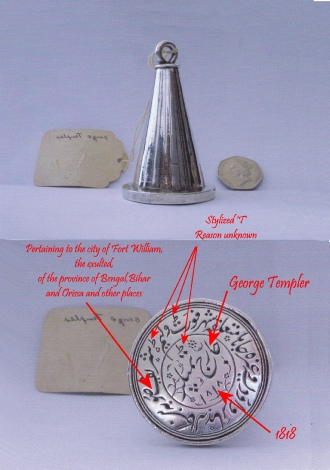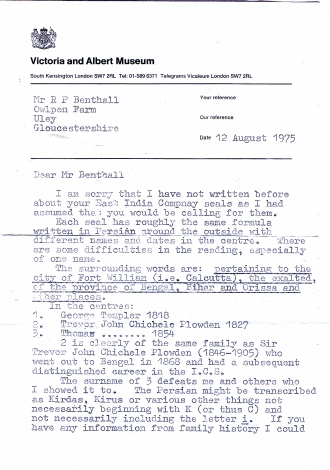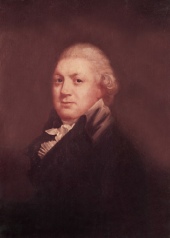George Templer of Jungpore
George Templer Jane Templer nee Paul
George, born 1755, the 4th son of James Templer.
George was educated at Westminster, (King’s Scholar 1770) and joined the Bengal Civil Service, about 1775 in Calcutta. He married in Calcutta, in 1781 Jane Paul of West Monkton, Somerset, who had arrived in the HEICS ship ‘Haleswell’, in which later George’s brother Charles Bickford Templer was drowned on the coast of Dorset 8th January 1786.
By about 1785, George had made a fortune supplying elephants to the HEIC and returning to England he bought Shapwick House near Bridgewater, Somerset.
In 1790 he became M.P. for Honiton, which seat he held until 1796, in spite of a challenge against his election in 1790, alleging bribery & corruption. The appeal was dismissed, although the petition was held not "Frivolous or vexatious."
About 1800 he sent off a letter offering to buy the nearby Cossington Estate, which his friend the Rev. Hobbs forgot to post, thereby losing the chance.
Instead with five friends, Edwards, Smith, Middelton, Johnson & Wedgewood (of Josiah fame), he founded the Middlesex Bank in London. In an unlucky moment about 1816, the Bank insured a fleet of merchantmen who were wrecked of the coast of Portugal. The ’Bank failed and were taken over by Messrs Coutts.
There still remain in the Templer family a miniature of him in 1789, his silver gilt cup and a large Armorial China service with his crest & Coat of Arms. On the failure of the Bank he returned to India, was offered a seat on the Supreme Council and became Commercial Resident of Jungapore, where he died and was buried in 1819, after, like his father, an eventful life.
His eldest son Rev. George Henry (1782 to 1849) was for many years Vicar of Shapwick, his 2nd son John William (1794 to 1873) served for 33 years in the Bengal Civil Service. His 3rd son Rev. Janes Acland was for many years Vicar of Puddletown, Dorset, all his sons being educated at Westminster. His only daughter Sophia Ann (1788 to 1808) married her 1st cousin Sir William Templer Pole Bart, of Shute near Heniton, Devon.
1755 - Born in Rotherhithe, Kent.
1768 - Educated at Westminster School. King's Scholar in 1770.
1773 - Entered the Civil Service of the East India Company, and arrivedin India as a Writer.
1774 - Appointed Assistant Deputy Commissary General.
1779 - Appointed Factor and Contractor for Elephants.
1781 - 5th March, George married in Calcutta, Jane Paul, eldest daughter of Henry Paul of West Monkton, Somerset. Henry Paul was also in the service of the HEIC, and his daughter, Jane, went out to India in the "Halsewell', the very same ship in which her brother-in-law, Charles Beckford, was wrecked and drowned off the Dorset coast some 5 years later.
1782 - On 4th January, George's eldest son, George Henry, was born in Calcutta, and baptised there on 25th January.
1783 - George was appointed Junior Merchant, without employ. 'Junior Merchant without employ probably meant that George was permitted to trade on his own account as well as for the East India Company.
1783 - George became member of the Grain Committee.
1784 - George appointed Senior Merchant, but in the same year he returned to England, by this time a very wealthy man. He was a friend of Warren Hastings and corresponded with him regularly between 1784 and 1817. He was also a friend of Thomas Graham, his wife's sister's husband, who became President of the Board of Revenue in Bengal, and was on the Supreme Council for India from 1774-1818. He corresponded with him on HEIC business between 1786 and 1818.
1785 - Shapwick House and the estate was purchased from Denis Rolle. The location was presumably influenced by the presence of his wife's family not too far away at West Monkton. George was involved in projects to drain the local Somerset marshes and improve the sea defences. These were the same marshes where Alfred the Great hid from the Danes and burnt the cakes! George's purchase of Shapwick took him back to the same part of Somerset from which his ancestors had originated, but had left in Tudor times, but it is doubtful if George was aware of this. Like many wealthy people of the day, he lived in style, and even had his own crockery, produced in China, which incorporated the family Coat of Arms. This was in addition to the usual crested silver cutlery etc.
1788 - Eldest daughter, Sophia Anne, born, and baptised on 14th January at Teigngrace Church.
1790 - George entered Parliament as Tory M.P. for Honiton. George's opponent in the Parliamentary Election was James Fraser who petitioned Parliament against George's return, accusing him of bribery and corruption. Honiton only had 500 electors and it was said that George had paid them 4 guineas each to vote for him. He still only won by 3 votes! On 23rd March 1792, the Parliamentary Committee that had been appointed to investigated the allegations, reported that George Templer was duly elected, but that the petition was 'NOT frivolous or vexatious!'
1793 - Along with some other wealthy Nabobs, George established a bank, known as "Edward, Smith, Templer, Middleton, Johnson and Wedgwood". This bank is sometimes know as 'The London and Middlesex Bank.
1794 - The name 'Smith' removed from registered name of the bank. George's second son, John William, born on 26th November. From time to time George was was a shareholder of HEIC.
1795 - George decides to leave Parliament, and does not stand at the 1795 election. During his time in Parliament he never made a single speech, and there is some suggestion that he did not enjoy being an M.P. He confided as much to a friend.
1797 - His third and youngest son, James Acland, born.
1804 - George's daughter, Sophia Anne, married on 24th August, her 1st cousin, Sir William Templer Pole, Bart., the son of George's sister, Anne. (Lady de la Pole).
1806 - Name of bank changed again to 'Davison, Noel, Templer, Middleton and Wedgwood.
1807 - George's eldest son, George Henry, married on 21st May, Anna Graham, daughter of Thomas Graham of Kinross, George's brother-in-law and old friend from HEIC days. George Henry, and Anna were first cousins, but this was not unusual in those days. George Henry had taken Holy Orders and his father gave him the living of Shapwick.
1808 - Sophia Anne, George's daughter, dies on 17th March having produced a number of de la Pole children.
1816 - The bank went broke. Tradition has it that in a rash moment the Board decided to go into insurance and accordingly provided cover for a fleet of HEIC ships. Many of these were subsequently wrecked on the Scilly Isles, and all the main shareholders were called upon to cover the losses. GT could only do this by selling Shapwick. The residual assets of the bank were bought by Coutts & Co. (now part of Natwest/RBS).
George's second son, John William, married on 18th June in Calcutta, Charlotte Wintle, second daughter of James Wintle of the Bengal Civil Service.
1817 - George was one of the donors of the Warren Hastings cup at Westminster School. On 13th May, he returned to India with his wife, having been given by the HEIC the unprecedented concession of re-appointment at his old rank. On arrival received a subsistence allowance only, pending the availability of a trading vacancy.
1818 - George was appointed Commercial Resident, Jungpore. There are some reports that GT was at some time in his career variously on the Supreme Council for India, and also Sheriff of Calcutta.
1819 - 20th July, (some reports say 14th), George died of a fever in Jungpore, and is buried there. His wife wound up his estate in Bengal and returned to England. She then went to live at Shute with her sister-in-law, Dame Anne de la Pole, and in due course died there on 27th June, 1847, aged 86. She is buried in the de la Pole vault at Shute. She was apparently a beautiful woman, and even in her old age was described as a 'very pretty old lady".




.jpg)
